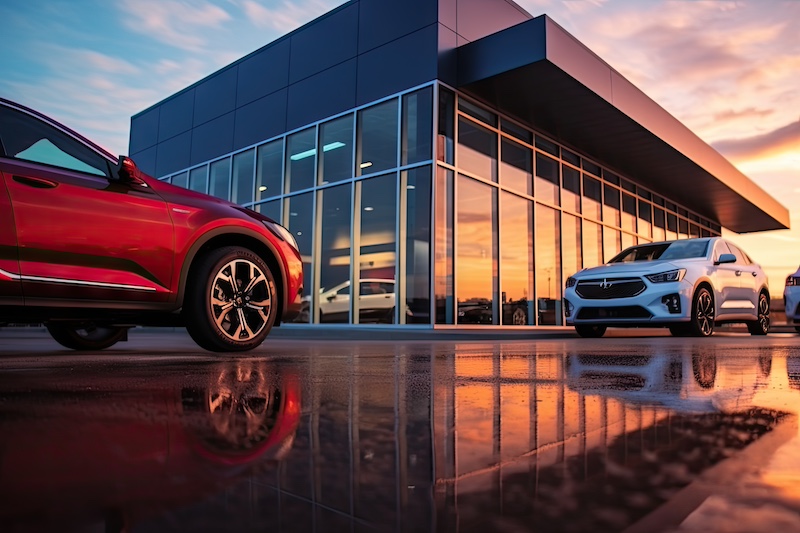By Tim Copacia, Executive Vice President, UnityWorks
Step right up!
Do you recall the last time you walked down a carnival midway? You just wanted to enjoy the walk, but all you could see and hear were barkers trying to grab your attention to play their games. Todays automotive dealer website experience is eerily similar. Dealer websites are filled with pop-ups, test drive lead forms, floating chat widgets, and overpowering billboard graphics. Dealer websites are slow, cluttered, and cold. They are the antithesis of personalized customer experience and a far contrast from other websites selling consumer goods and services.
And because most retail automotive organizations and OEM digital partners are obsessed with leads as a primary KPI, they continue to push lead forms in front of consumers before they have even started their car shopping journeys. Think about it would you like to go into a store to make a considered purchase (like a new car, which may occur every three to six years) and have different salespeople asking for your name, phone number, and email before you even begin to browse? Of course not.
Too Many Choices, Too Many Different Experiences
With OEM digital programs offering multiple certified website vendors to choose from, not only does this poor experience continue, it proliferates across five to seven websites.
After spending many years advocating the value of a customer experience management strategy, I know that it is critical for OEMs and dealers to focus on making the auto shopping experience as simple, easy, and painless as possible. You must allow consumers to shop based on their needs and their budget, their way. Shortsighted is the impersonal website that accentuates unfriendly and old-school sales tactics along with a belief that the primary role of the dealer website is purely inventory listings.
Did you know that 62 percent of millennials see the dealer website as a primary source for auto shopping? Even though we have all been conditioned to believe that the heavy lifting from a research standpoint is done on T1 sites or research sites, a positive retail auto website experience could mean the difference in choice of brand, model, and/or dealership. Transparency is crucial in arming the shopper with the information needed to make an informed buying decision.
I believe that the retail shopping experience needs to be comprehensive, inclusive, and as connected as possible. If we are successful in attracting just one of the two million people in the country who will buy a new car in the next two months to the dealer website, we must do all we can to engage them and keep their interest.
Wheres the Video?
When 80 percent of all internet consumption is video, it is fair to presume people love video and want more of it. New car buyers are hungry for more video content because they would rather watch than read. With video, you can create an emotional connection and desire that you simply cant do with words. Look at dealer websites today. Where is the video content? Where is the dealer’s about us video? Where is the video promoting service? Where is the video highlighting different models or specific VINs?
The answer is (in most cases), its not there. Its almost 2020, and most dealer websites have little to no consistent video experience.
The Need for A Consistent Presentation for all Models
I recently tried to convince an automotive website client on the need to create a consistent video presentation for each brand model on the dealers website. I suggested they include a model video overview of each model and additional video content by model for safety, performance, and technology. I suggested that they integrate this model content throughout the site and within an easy-to-navigate full lineup video showcase.
I said if video is that important to auto shoppers, why wouldnt you want it on the dealers site? I also said that with an OEM spending over a billion dollars on a new-car platform, do you really want seven different website companies providing seven different representations of the same model across the customer experience? The answer was, We believe in video, but we would never fund it. What?
Most Dealer Website Traffic is Lost and Unmanaged
The purpose of a campaign from a digital ad partner is to drive traffic to the dealers website or directly to the showroom. If someone is ready to buy now and interested in a specific VIN, then take them there as soon as possible. Give them a great price and reason to buy from you, and youll quickly close the deal.
However, most people who visit the dealers midway experience are not ready to buy. Unless a consumer hits an inventory page and gets a retargeted display ad, chances are that over 90 percent of the traffic to the dealer website is lost and unmanaged.
I believe there is a better, faster, and more personalized solution. Rather than dropping a prospect on the homepage, why not take them to a customer-centric microsite (site within the site) where they can shop at their own pace, hassle-free? Allow them to navigate their experience the way they want. And provide all the key components of information to guide the shopper to make a buying decision.
The components within this experience include questions and tools to make the experience relevant and useful, such as time frame to buy, targeted monthly payment, trade-in value, build and price competitive comparisons, current offers, and incentives, robust video content on all models, a why buy overview about the dealer, and an opportunity to save their activity on a mobile wallet for easy retrieval and offer updates.
This complete personalized shopping experience is entirely data-driven and customer curated. It fills the void of todays websites by providing an experience that seamlessly moves a prospect to a buyer. It is not meant to replace the dealer website but to complement it with a consistent and integrated platform fueled by accurate data, video content, and dealer customization.
The Ultimate Data-Driven Personalized Experience
At UnityWorks, we offer a new solution called PSX, or Personalized Shopping Experience. It consists of three core pillars to optimize traffic, create a more efficient vehicle shopping process for the dealership, and a comprehensive omnichannel intelligent remarketing process to nurture prospects who are not ready to buy.
Lets examine each pillar a little deeper.
Pillar #1: The Advertising. We use multi-platform dealer advertising on the industrys leading media platforms to serve micro-targeted video campaigns that drive prospects to PSX. The content on each platform is unique and focused on mobile-first, vertical video viewing. We create custom model ads that are conquest or retention based. We promote the dealer, the model, the offer, and the experience. We dont expect a 15-second ad to sell the car. We want to spark an interest that invites the viewer to enter the PSX experience to dig deeper and learn more.
Pillar #2: The Personalized Shopping Experience is a complete and integrated vehicle shopping experience that can be quickly adapted to any brand or dealership. It is a marketing tech platform that provides a robust, personalized shopping assistant that keeps prospects engaged and makes owners more likely to return. This micro-site is visible on the dealer site, becoming an alternative digital storefront for the dealer and the consumer. Every action is monitored via a robust dashboard for appropriate follow-up action.
Pillar #3: Omnichannel Intelligent Remarketing. Based on the customer activities within PSX, we can proactively and reactively deliver follow-up messages to any prospect that has touched the website or PSX. This goes far beyond traditional retargeting VDP viewers and includes the use of Facebook, Instagram, Messenger, email, and mobile wallet. This is the real opportunity to manage the unmanaged that may not be ready to purchase for another 90 days yet landed on the dealer website as an initial step in their purchase journey.
The Personalized Shopping Experience vs. Digital Retailing
Although there is lots of new industry buzz around digital retailing tools, the Personalized Shopping Experience is much different. It does not try to desk a deal online. It is not going to dictate new in-dealership processes or prompt a dealer to revamp their lead management process and follow up.
It starts with adding a more consumer-friendly destination to multi-platform video campaigns mostly focused on generating new customers. It promotes the experience and the vehicle and positions the dealer differently by offering a better mobile-friendly shopping experience. This itself is valuable to the dealer and the consumer.
PSX then neutralizes some of the noise and clutter of the current website midway experience. It provides a customer-driven approach vs. hard sell, lead gen tactics. If a shopper engages, great! If they leave, we invite them back. If they saved some of their activities, they can come back anytime where they left off. If they want to go to inventory now, great! If not, they can build and find a similar vehicle on the lot when ready.
Once the intelligent remarketing kicks in, we provide useful and valuable follow up on behalf of the dealer. Our collective goal is to do such a great job on the digital shopping experience that they will travel to the specific dealer when ready.
I believe this new comprehensive PSX process will help improve the impact of video campaigns not only if using UnityWorks, but ultimately any certified provider trying to use search, display, email, social to drive website traffic.
Act Now and Gain More Sales
It is time for the retail website experience to grow beyond cold inventory listings and shouts for attention. We need to provide todays savvy digital shopper with a customer-friendly place to make a buying decision. A place where video content is abundant and integrated across the sites to consistently present each model and VIN across the enterprise. A personalized experience and intelligent remarketing process that truly guides the customer.
A connected customer strategy through a Personalized Shopping Experience will create another distinction for the dealership, overcome the challenges of todays dealer websites, and convert more shoppers to buyers.
About the Author
Tim Copacia is EVP of strategic development at UnityWorks. He is a former agency CEO and automotive pioneer in digital marketing, CRM, customer experience management and data-driven video experiences. He has led multi-million-dollar omnichannel marketing programs across all marketing tiers for several major OEMs.







